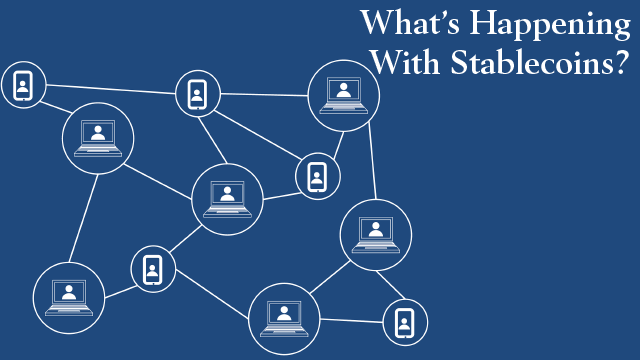
Bill Hillman, a bull running enthusiast, wrote a book about how to avoid being gored by a bull while bull running. Three weeks after the book’s release, he was gored by a bull while bull running[1].
Life is full of irony and the Cryptocurrency market is no different. As the markets have slid over the past few months, you may have heard about the crash of a stablecoin called Terra (UST), wiping out a combined $60 billion in market value with it[2]. Stablecoins peg themselves, and therefore derive value, from a hard asset like the U.S. dollar. However, Cryptocurrency was created as a hedge against the dollar (and currency in general). Hmmm…
You’re wondering, then, how could an asset tied to the U.S. dollar, which even has “stable” in the name, have such a precipitous fall?
What makes Terra different than traditional stablecoins is that it’s an algorithmic stablecoin. Algorithmic stablecoins like Terra (there are subcategories of algorithmic stablecoins, but we’re going to be talking about the most high-profile one in this article) are backed by math and other cryptos, not hard assets. They depend on an algorithm that keeps the price level by automatically managing the token circulation supply. If the market price of the coin drops below the fiat currency peg, then the number of coins in circulation is reduced, theoretically driving the price up. Conversely, if the price rises above the peg, then the number of coins is increased, theoretically driving the price down.
If the circulation being increased and reduced seemingly on a whim sounds a bit like a regular old currency, you’re right. That’s why there is another side of this seesaw. In Terra’s case, it’s backed by another coin on the Terra blockchain called Luna.
1 coin of Terra = $1 = 1 coin of Luna.
This balance is supposed to keep the stablecoin, well, stable.
Terra can be exchanged for Luna and vice versa. Terra derives its value from Luna and Luna derives its value from Terra. As long as Terra stays connected to the dollar and Luna stays relatively stable or goes up, everything is hunky dory. But if either has a huge decline, deviating outside of those parameters, it creates an ouroboros of negativity neither coin can escape.
That’s exactly what happened. Large sell offs of Terra caused its dollar peg to break, the algorithm tried to flood the market with new Luna coins in an attempt to drive the price of Terra back up, but more Luna coins meant Luna crashed further. Investors, seeing the writing on the wall, started selling off both, exacerbating the situation even further, leading to less confidence the peg would ever be established again, causing Terra to go down further leading to more Luna coins being produced…
*Deep Breath*
Hello snake, open up wide for your own tail.
The problem was that Luna itself had no intrinsic value. Its value was derived from nothing but words, thoughts, theories, hopes, and illusions. Luna tokens had once been trading over $100. As of May 22, Luna was trading at $0.0002[3]. In a market that has been roiled with extreme volatility, the Terra/Luna saga has been one of the most extreme cases.
In a downdraft market, there can’t be such thing as a stable stablecoin because the algorithm behind it breaks. In that way, it’s just like every other market. Traders have tried to find the perfect hedging model since the beginning of trading but, in an extreme downturn, all bets are off. In markets like cryptocurrency or the options market, the chaos moves so fast that you close your eyes to bask in the sunlight for a moment and open them in the middle of a lightning storm.
So what’s the point of these algorithmic stablecoins anyway?
Proponents of decentralized finance see algorithmic stablecoins as the “holy grail,” the pinnacle of what this emerging technology could be. In a perfect world, traditional stablecoins are backed dollar-for-dollar in hard assets but how much of it being truly a 1:1 ratio can be murky. Even still, those real hard assets are regulated by some sort of governing body, a gatekeeper if you will, standing between real people and the control of their money. Algorithmic stablecoins offer an alternative. A self-contained currency system that does not rely on any entity that has ties to regulatory interference – the true embodiment of what Cryptocurrency was created to do.
On the other hand, as Terra/Luna demonstrated, the fear of missing out drove many individuals to invest in an asset with no underlying value, which was not as stable as it claimed.
Or maybe it wouldn’t have mattered either way, with the allure of outsized returns overwhelming the risk causing them to do it anyway. After all, many of those who consider themselves experts in the field could not have predicted the speed and extremity with which Terra and Luna collapsed.
Perhaps when you run with the bulls, no matter how prepared you are, sometimes one catches up with you.
Joe Gallina
 Joe has a degree in Finance from the University of Illinois at Chicago. Afterwards, he worked for Morgan Stanley and Bank of America/Merrill Lynch, obtaining both Series 7 and 66 licenses. At Merrill, he was on the self-directed side of the business, exposing himself to every aspect of the financial services industry.
Joe has a degree in Finance from the University of Illinois at Chicago. Afterwards, he worked for Morgan Stanley and Bank of America/Merrill Lynch, obtaining both Series 7 and 66 licenses. At Merrill, he was on the self-directed side of the business, exposing himself to every aspect of the financial services industry.
Copyright © 2022 Protinus. All rights reserved.
[1] https://people.com/books/man-who-wrote-a-book-about-surviving-bull-running-is-gored-by-a-bull/
[2] https://www.bloomberg.com/news/articles/2022-05-19/luna-terra-collapse-reveal-crypto-price-volatility
[3] https://www.coinbase.com/price/terra-luna
